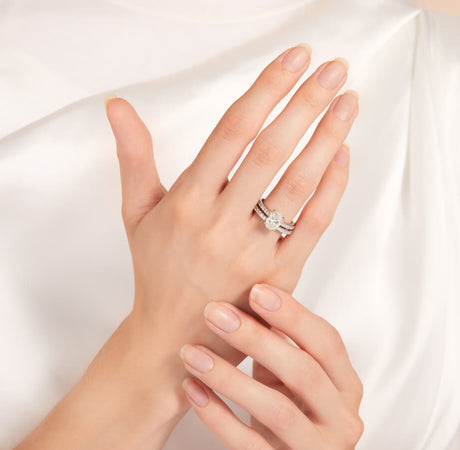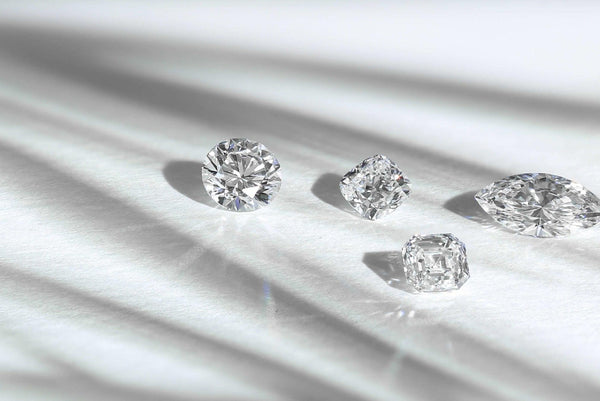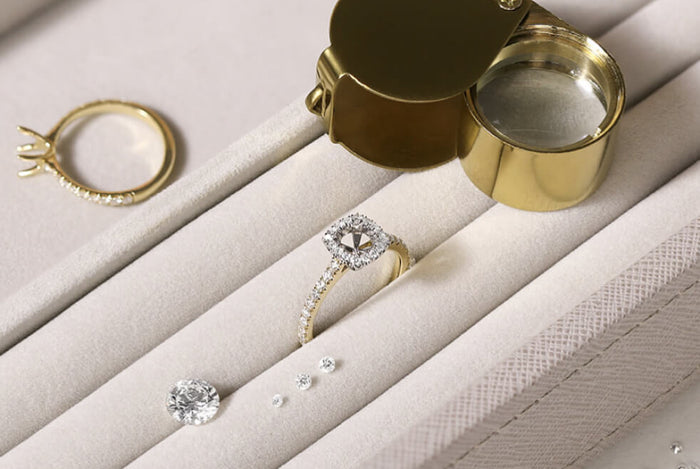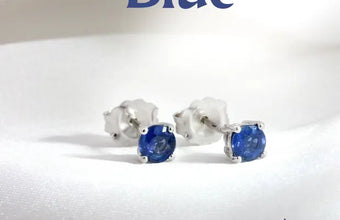What are the 4cs?
The 4 Cs represent the four main characteristics that play a role in a diamond’s beauty, quality and structure. There are several factors to consider when choosing the perfect diamond for your unique engagement ring, the 4 Cs being the key characteristics that can make or break your decision. The goal is to find the ideal combination of characteristics - cut, colour, clarity and carat - which are each given a grade. Whilst we consider ‘cut’ the most important characteristics to prioritise, an exceptionally beautiful diamond is one with a fine balance of all four; a perfect harmony.
The 4Cs & the GIA
When it comes to determining the grade of a diamond, it is important to rely on an expert, quality assessment, rather than in-house or unreliable graders, who may give a diamond more credit than it’s due to boost the value of the stone. The GIA are an independent, not for profit organisation that are globally recognised as the most trusted and respected diamond graders. At Holts Gems, we proudly supply GIA certified diamonds, to ensure the diamond you choose has already been through rigorous assessment to assess its characteristics and value. GIA certified diamonds are inscribed with a miniscule, unique code, visible under 50x magnification, which proves the diamond belongs to its accompanying certificate. A diamond’s GIA certificate is a little like it's passport, which verifies each stone’s identity - and much like a passport, it’s important you keep ahold of it!
How much do diamonds cost?
Diamonds are exceptionally beautiful and their rarity is unrivalled, hence the intrinsic value that they possess. However, a number of properties can vastly alter their value; as unique products of natural processes, no diamond turns out the same, and this disparity can affect the cost of a diamond. When it comes to selecting a diamond for your engagement ring, cost may be the last thing you want to think about, but defining a budget can be a great way to begin your diamond search. To understand how valuable a diamond is, it is helpful to understand the 4 Cs - and recognise that the more optimal each characteristic, the more the diamond’s cost.
The 4 Cs - what does diamond cut mean?
Along with most industry experts, we consider ‘cut’ to be the most important of the 4 Cs. Rather than the shape of the diamond, cut refers to the dimensions that each facet has been cut and polished to. An optimal cut grade will see facets that are perfectly proportioned, and have been cut to precise and intricate angles that best enhance the diamond’s sparkle. The cut of a diamond determines the overall finish of the stone and greatly affects how well light passes through the stone, referred to as its ‘brilliance’.
A modern round brilliant diamond consists of 58 facets - the main one you will hear about is the ‘table’, the flat facet on the top of a diamond. As the top of the diamond is how it will most commonly be viewed, the table plays a critical role in the diamond’s appearance. The table refracts light rays to each of the other facets, which is what gives a diamond its sparkle. Essentially, the better the cut grade, the sparklier the diamond!
The size of the table has to be well balanced with the rest of the diamond cut - in this case, bigger is not necessarily better. If the table is too large the upper facets will not have room to disperse light, and if too small, then not much light will be able to enter the stone.
Cutting a diamond is an intricate and highly skilled process, and each diamond is cut and polished by hand - striking the perfect balance is a fine art. As cutters vary in prestige, diamonds aren’t always cut to the best of their potential, which results in a poor gut grade that should be avoided. As our experts hand pick each diamond we show our clients, any stone that is ill-proportioned, non-symmetrical or poorly finished won’t make the cut into our studio.
Unfortunately, some jewellers choose cuts that maximise the size of the diamond. Such poorly cut diamonds are, however, lacklustre and dull, and don’t offer the brilliance of an ‘excellent’ or ‘very good’ cut grade. The more precise and symmetrical the cut, the better the light refraction and therefore the sparklier it is.
The 4 Cs - what does diamond colour mean?
The colour grade of a diamond is what we consider to be the second most important of the 4 Cs. As with each of the 4 Cs, the GIA grade ‘colour’ on a scale, referring to the amount of colour present in a diamond. Whilst diamonds occur in what are referred to as ‘fancy’ colours, most diamonds are ‘colourless’. Having said this, ‘white’ diamonds contain traces of nitrogen which can make the diamond appear yellow or even brown in tone. The scale begins with D which signifies the stone is ‘colourless’ and is the highest-quality colour grade a diamond can receive, down to Z which is yellow or brownish. The further towards Z, the stronger the presence of undesirable hues.
So which diamond colour grade should you aim for? Holts Gems recommend sticking between D and F, which is within the ‘colourless’ range. The difference between diamonds graded D - F is minimal, and unidentifiable to the average eye. Diamond colour grades from H and further down the scale decrease in beauty, changing from icy and colourless to yellow or brown hues.
Typically considered rarer than colourless or white diamonds, the cost of fancy colour diamonds depends on the strength of their colour. Available in intense yellows (as opposed to the ‘dirty’ looking yellow of poor colour graded diamond), pinks, greens, blues and black, a more vivid colour will typically carry and heavier price tag.
Colour grade can have a relatively big impact on a diamond’s cost, but as the colour differences can be visible to the naked eye, we recommend that it's a good characteristic to prioritise. If you’re choosing a yellow gold or rose gold setting, you may be able to get away with a diamond on the lower end of the ‘colourless’ range, but platinum settings should hold a diamond that will look as equally as bright and icy white.
The 4 Cs - what does diamond clarity mean?
The GIA states that a diamond’s clarity grade describes “the appearance and placement of characteristics both inside the diamond and on its surface”. Diamonds are formed deep within the earth, under heat and pressure for billions of years, and over this time, they pick up a number of other minerals which cause these imperfections. It is very rare to find a stone without any structural imperfections, or that is ‘flawless’. Some like the idea of the odd inclusion in their diamond, as this validates the long history of the stone and how it has formed. When these ‘birthmarks’ are located on the stone’s surface they are known as blemishes and when they are found inside the stone they are called inclusions. No diamond is the same, and almost every diamond has imperfections when viewed under a 10x magnification.
We use the GIA standard clarity grading system which measures the degree to which these flaws are present, starting from 'Flawless' to 'Included 3'. Diamond clarity is graded with codes such as 'SI2', SI1', 'VS2', 'VS1', which translates as 'slightly included 2', 'slight included 1', 'very slightly included 2', 'very slightly included 1', and so on. Flawless stones are graded 'FL' and 'IF', and heavily included stones 'I1', 'I2'. A flawless ‘FL’ diamond is extremely rare, it must have no internal or external blemishes when put under a 10x magnifying glass. But is finding a flawless diamond really that important?
Diamond clarity needs to be considered alongside the other 4 Cs, as they play a role in how important it is to select the right clarity, based on your budget. Some diamond cuts are more forgiving than others when it comes to determining clarity. The broad, flat facets of step cuts like the Emerald and Asscher cuts will accentuate any imperfections in the diamond so any inclusions below VS2 clarity are likely to be visible to the naked eye. A round brilliant cut diamond, on the other hand, can help disguise inclusions by breaking up the light as it is reflected from the many facets on the diamond’s surface.
Typically, inclusions are only visible under intense magnification, so it is not one of the most important of the 4 Cs and is good characteristic to compromise on. We advise clients to go for ‘eye clean’ diamonds, meaning avoid diamonds with inclusions visible to the naked eye. We recommend sticking between SI1 and VS2, both these grades and between will be ‘slightly included’ or ‘very slightly included’ which will unlikely be seen by the naked eye. We don't recommend going much higher than a VS2, as the difference in appearance is insignificant without a 10x magnifying glass, but will have a higher price tag.
The 4 Cs - what does diamond carat mean?
Diamond carat weight is a measurement of how much the stone weighs, a metric “carat” is defined as 200 milligrams, or one fifth of a gram. You will here gemmologists and jewellers talking about carats and ‘pointers’, this is because each carat is made up of 100 ‘points’. Very few diamonds weigh exactly one or two carats. In order to provide a more accurate weight for all diamonds, carats are divided into hundredths, allowing very precise measurements to the hundredth decimal place. For example a diamond that weighs 0.45ct, is a ‘forty-five pointer’.
Whilst diamond carat weight significantly impacts the cost of a diamond, a high carat weight will be totally devalued by a poor cut, colour or clarity grade. For example, a stone with high carat weight, but poor cut may appear smaller or larger than an excellent cut stone, with a much duller appearance due to the poorly executed facets. While you may have an idea of the certain carat weight you’d like to hit, don’t neglect the importance of cut and colour, which have a huge impact on the beauty of the stone. When you sacrifice a few carat points, the difference between size may even seem negligible - few could tell the visible difference between a 0.95ct and 1ct diamond, yet the price difference will certainly be significant.
It goes without saying, larger diamonds are a lot rarer than smaller stones, which is reflected in their value, which increases exponentially with carat weight. Our diamond experts know all the tips to help you get the best stone for your desired budget, and knowing how to compromise on carat weight without impacting the beauty of your diamond engagement ring is something they are well equipped to help you with. If you are looking for a 1 carat stone, for example, you could get a beautiful diamond in terms of cut, colour and clarity if you aim for a stone just under 1ct - the size difference will be negligible but the price difference is considerable. A way to optimise your budget is by choosing ‘undersized’ or ‘oversized’ diamonds, diamonds are priced according to the rounded decimal, so 0.50, 0.75, 1.00, and so on. Therefore, choosing a stone that weighs slightly over or under the 1ct round up bracket, could offer great value for money, for example a 0.93ct diamond will be priced within the lower bracket, but will look strikingly similar to a 1ct. Over the 1ct mark the price hugely increases.
If this seems a little complicated, our diamond experts know the 4 Cs inside out, and are on hand to guide you through the process whilst offering their expert advice. They know which characteristics to favour and which to compromise on, whilst also being considerate of your design needs. You may want the sparkliest stone, but not fussed about size! Or you could want the biggest possible stone, in which case you compromise a bit on colour! It is a fine balance of your design needs and the guarantee that you will be getting the absolute best for your budget!









